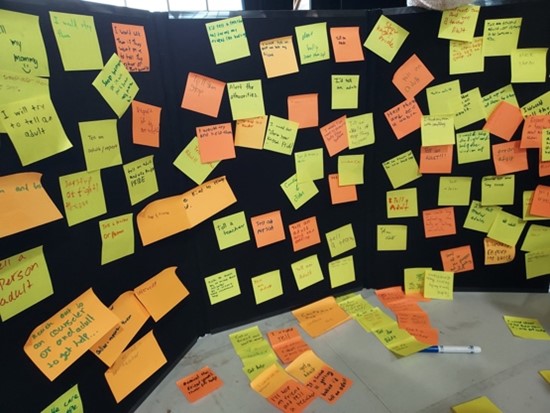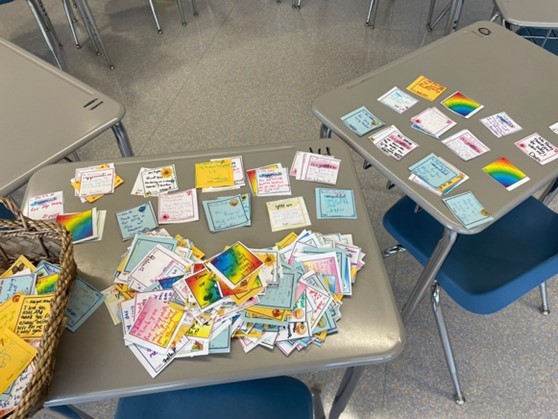Early childhood education plays a crucial role (National Scientific Council on the Developing Child, 2007) in shaping children’s cognitive, emotional, and social development. The quality of classroom environments significantly influences these outcomes, particularly in mental health and behavioral wellbeing. While individual child interventions address individual-focused challenges, counselors, educators, and child development professionals can foster positive emotional and social experiences by improving “classroom climates.” Here are tips for creating a supportive, nurturing learning environment.
Why Classroom Climate Matters: Especially for Military Children
A child’s emotional, social, and cognitive development is deeply influenced by the quality of their classroom learning environment. Emotional security, structured routines, and positive teacher-child interactions significantly impact greater emotional regulation and resilience in children, improved peer relationships and cooperation, and strong self-management of behaviors and emotions. For children from military families (Park, 2011), classroom climate is particularly important as transitions, parental deployment, and relocation stress impact their emotional wellbeing.
Addressing Systemic Challenges in Early Childhood Settings
Supporting children’s behavioral and emotional wellbeing in development centers presents numerous challenges. Early childhood educators today face growing challenges (Lester & Flake, 2013), including limited resources, staff turnover, and increasing numbers of children who require additional support to thrive. Amid these demands, the focus often leans heavily toward academic preparedness, leaving less opportunity for professional development around fostering supportive emotional climates.
Access to resources for mental health and emotional wellbeing is also limited, with in-person, professionally trained licensed mental health providers being scarce (National Research Council and Institute of Medicine, 2009), highlighting the need for proactive interventions within the classroom. These challenges are even more pronounced in military-connected early childhood settings, where frequent relocations and deployments can leave both parents and educators with limited knowledge of available community resources, further complicating efforts to support children’s social-emotional development.
Aligning with Existing Frameworks for Greater Impact
The principles of a “climate scale” can provide consistency in the classroom. By providing interventions modeled after the Preschool Mental Health Climate Scale tool, early childhood counselors and educators can provide support across staff and centers and give practical tools to ensure that teachers are better equipped to manage some of those challenges. Here are two scales that have been effective in our years of providing counseling to military families.
The Early Childhood Environment Rating Scale (ECERS) (Harms, Clifford, & Cryer, 2015) is a tool to assess and enhance classroom environments and practices. It provides a structured framework that allows educators to evaluate key aspects of the learning environment using consistent, research-based criteria. By working within a system that employs ECERS, a child development professional can align consultations with a language and set of expectations already familiar to staff. This shared reference point streamlines communication and facilitates more targeted, collaborative problem-solving. As a result, the counselor or teacher is better equipped to provide relevant and actionable support that resonates with children and families and reinforces existing developmental goals.
Another framework to consider is the Preschool Mental Health Climate Scale (PSMHCS) (Borelli et al., 2019). The PSMHSC is composed of several sections that emphasize various classroom environmental factors. Each section enables a child development professional to recognize deficiencies and implement appropriate interventions. The PSMHCS details how classroom environments impact child behaviors. It will help identify common stressors, such as chaotic transitions or a lack of emotional support strategies and provide actionable strategies to improve classroom climate without major disruptions to routines.
Applying the Preschool Mental Health Climate Scale
Here are some common classroom challenges and interventions for teachers and counselors to address with military children, youth, and families.
1. Transitions Between Activities
Challenge: Children become restless and disruptive during transitions.
Teachers: Model strategies for pre-transition warnings and use verbal and visual cues during classroom instruction.
Counselors: Ask reflective questions like, “How do you think you should respond when there’s a sudden shift in activities?” or “What small changes could make transitions smoother?” to promote self-reflection and ownership of improvement.
2. Directions & Rules
Challenge: Inconsistent enforcement of rules or lack of clear expectations.
Teachers: Assist in developing visual rule charts, creating consistent rule systems, and integrating social stories to reinforce expectations.
Counselors: Model using positive reinforcement and consistent follow-through with consequences.
3. Behavior Challenges
Challenge: Behavior escalation due to limited classroom monitoring.
Teachers: Demonstrate active supervision techniques, including effective classroom movement and awareness.
Counselors: Train on recognizing early signs of distress and strategies for proactive engagement.
4. Emotional State
Challenge: Emotional state negatively impacts the classroom climate.
Teachers: Facilitate self-reflective discussions about how personal stress, including military-related challenges, influences attention.
Counselors: Train on stress management tools, have individual support sessions, and provide referrals to appropriate resources as needed.
5. Child Interactions
Challenge: Limited engagement, minimal physical warmth, and lack of responsive dialogue from staff to children.
Teachers: Ask open-ended questions, have eye-level interactions, and use warm engagement strategies like high-fives and active listening.
Counselors: Demonstrate personalized connection-building techniques with children to promote relational trust and engagement.
6. Transitions Between Activities: Emotional Awareness & Problem-Solving
Challenge: Children struggle to express emotions and rely on adults to resolve conflicts.
Teachers: Help label emotions and guide children through peer conflict using visual tools like emotion charts.
Counselors: Model emotional coaching strategies and demonstrate conflict resolution techniques in the classroom setting.
7. Individualized & Developmentally Appropriate Lessons
Challenge: Rigid, non-differentiated instruction for children with varying needs.
Teachers: Model strategies that promote flexibility, such as offering choices, using sensory-friendly materials, and adjusting activities to meet diverse needs.
Counselors: Reinforce self-regulation skills, offer coping strategies during challenging activities, and help children navigate transitions through individualized support.
8. Child Interactions
Challenge: Peer conflicts are frequent; socialization needs.
Teachers: Model strategies for promoting cooperative play and supporting positive social interactions among peers, offering real-time examples in classroom settings.
Counselors: Work with children on positive peer engagement, modeling turn-taking, social invitations, and conflict resolution skills.
Transforming Environments & Supporting Futures
By breaking down each component of the preschool mental health climate scale and integrating interventions into daily classroom activities, counselors, educators, and child development professionals can provide support and consultation and exemplify best practices for educators. Enhancing classroom climates can ultimately create healthier, more supportive learning environments to benefit both educators and students. These climate scale principles can be used as a support tool to positively transform early childhood learning environments, ensuring every child receives the emotional and social foundation for long-term success.
References
- Park, N. (2011). Military children and families: Strengths and challenges during peace and war. American Psychologist, 66(1), 65–72. https://doi.org/10.1037/a0021249
- National Research Council and Institute of Medicine. (2009). Preventing mental, emotional, and behavioral disorders among young people: Progress and possibilities. The National Academies Press. https://doi.org/10.17226/12480
- Domitrovich, C. E., Cortes, R. C., & Greenberg, M. T. (2009). Improving young children’s social and emotional competence: A randomized trial of the Preschool PATHS curriculum. Journal of Primary Prevention, 30(3-4), 329–345. https://doi.org/10.1007/s10935-009-0171-0
- Harms, T., Clifford, R. M., & Cryer, D. (2015). Early Childhood Environment Rating Scale – Third Edition (ECERS-3). Teachers College Press.
- Borelli, J. L., Callaghan, C. L., Smiley, A. J., & Westervelt, H. (2019). Development and Validation of the Preschool Mental Health Climate Scale (PMHCS). Early Education and Development, 30(3), 318–338. https://doi.org/10.1080/10409289.2018.1546095
Further Reading
For those supporting young children’s social-emotional development and mental health, several established tools and resources can provide valuable guidance. The Early Childhood Environment Rating Scale (ECERS) (Harms, Clifford, & Cryer, 2015) and the Preschool Mental Health Climate Scale (PMHCS) offer frameworks for assessing classroom environments and the emotional climate within early learning settings. Additionally, resources such as the Devereux Early Childhood Assessment (DECA) Program, the Center on the Social and Emotional Foundations for Early Learning (CSEFEL), the National Center for Pyramid Model Innovations (NCPMI), and ZERO TO THREE provide practical strategies, evidence-based practices, and training materials to strengthen resilience, promote positive social-emotional growth, and address the needs of young children, particularly in dynamic environments like military-connected early childhood programs.
Additional Recommended Resources for Counselors Working in Early Childhood Settings
- Devereux Early Childhood Assessment (DECA) Program: A strength-based assessment and planning system designed to promote resilience in children aged 4 weeks to 6 years. https://centerforresilientchildren.org
- Center on the Social and Emotional Foundations for Early Learning (CSEFEL): Resources and training materials focused on promoting social-emotional development and school readiness in young children. http://csefel.vanderbilt.edu
- National Center for Pyramid Model Innovations (NCPMI): Support for the implementation of the Pyramid Model framework to promote young children’s social-emotional competence and address challenging behavior. https://challengingbehavior.cbcs.usf.edu/
- ZERO TO THREE: An organization dedicated to ensuring that all babies and toddlers have a strong start in life, with a wealth of mental health, trauma-informed care, and early development resources. https://www.zerotothree.org/
About the Author

Mary Sol Weston, LCPC-S, is a dedicated Licensed Clinical Professional Counselor with a specialization in family life counseling, trauma-informed care, and early childhood mental health. Coming from four generations of active-duty Service members, country and community is woven into her identity. She honors the legacy of her father’s distinguished 33-year military career and takes pride in her son’s current service in the armed forces.


